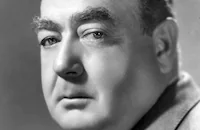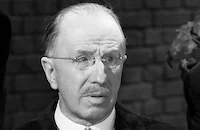Shanghai Madness
Brief Synopsis
Cast & Crew
John Blystone
Spencer Tracy
Fay Wray
Ralph Morgan
Eugene Pallette
Herbert Mundin
Film Details
Technical Specs

Synopsis
In Shanghai, Lieutenant Patrick H. Jackson is court-martialed and dismissed from the Navy for ordering his ship to fire upon a communist-held fort after they fired on his ship and killed two men because his order was in violation of a general order of the Commander-in-Chief. Pat's bitterness toward the Navy increases when he fails to find a job in Shanghai because of his notoriety. After he helps Wildeth Christie, the headstrong daughter of a wealthy businessman, escape a near-riot in a part of town in which she had been warned not to go, she makes a date with him for tea the next day. In a bar, when police find a young communist hiding, Pat is arrested for shielding him. In jail, when the youth is shot trying to escape, and Pat uses his own clothes for bandages and bribes a guard for water for him. After the youth dies, his father, Li Po Chang, obtains Pat's release and offers him work as a gunner on a ship he owns, the East Wind's Sweetheart , which he plans to use to carry arms to provinces whose warlords are fighting the communists. The next day, Pat dines with Wildeth, whose aggressiveness is attractive to him, yet after he kisses her, he tells her that he is not going to see her again. When Wildeth's father, who is upset about her daughter's infatuation with Pat, orders her to sail home, she sneaks onto Pat's ship. She is discovered after the ship has left Shanghai, and Pat refuses to talk to her. When she says that she will go home if he tells her he doesn't love her, Pat kisses her and makes plans to leave her at an American mission, after which she will return to Shanghai and meet him when he gets back. Wildeth, however, remains at the mission, and two weeks later, when the communists begin an assault on the waterfront, she assists as a nurse. The crew on the East Wind's Sweetheart see the fighting as they pass on their return to Shanghai, but when the communists fire at the boat, Captain Lobo Lornegan, an amiable and hard-drinking, but not very courageous officer, orders the boat to pull away. Pat, upset that the American flag at the mission is being flown upside-down, a signal of distress, threatens to fight Lornegan unless he gives orders to pull in to shore. Lornegan acquiesces and the Americans beat the communists in battle. Later, Pat, now married to Wildeth, is reinstated into the Navy.

Director
John Blystone
Cast

Spencer Tracy

Fay Wray

Ralph Morgan

Eugene Pallette

Herbert Mundin
Reginald Mason

Arthur Hoyt
Albert Conti

Maude Eburne
William Von Brincken
Frederick Burton
Crew
Ed Berry
Jasper Blystone
Margaret Clancy
Stanley Cortez
Warner Cruze
Louis De Francesco
Lee Garmes
Rita Kaufman
W. W. Lindsay Jr.
Edward T. Lowe
Jack Otterson
Austin Parker
Austin Parker
Al Rockett
John Schmitz
Emmett Schoenbaum
Winfield R. Sheehan
J. Sigler
H. C. Smith
Alexander Troffey
Gordon Wong Wellesley

Film Details
Technical Specs

Articles
Fay Wray (1907-2004)
She was born Vina Fay Wray, in Cardston, Alberta, Canada on September 15, 1907. Her family relocated to Arizona when she was still a toddler so her father could find employment. When her parents divorced, her mother sent her to Hollywood when Fay's eldest sister died in the influenza epidemic of 1918. The reasoning was that Southern California offered a healthier climate for the young, frail Wray.
She attended Hollywood High School, where she took some classes in drama. After she graduated, she applied to the Hal Roach studio and was given a six-month contract where she appeared in two-reel Westerns (25 minutes in length), and played opposite Stan Laurel in his pre-Oliver Hardy days.
She landed her first big role, as Mitzi Schrammell, in Erich von Stroheim's beautifully mounted silent The Wedding March (1928). It made Wray a star. She then starred in some excellent films: The Four Feathers (1929), the early Gary Cooper Western The Texan (1930), and one of Ronald Coleman's first starring roles The Unholy Garden (1931), all of which were big hits of the day.
For whatever reason, Wray soon found herself in a string of thrillers that made her one of the great screamers in Hollywood history. The titles say it all: Doctor X, The Most Dangerous Game (both 1932), Mystery of the Wax Museum, The Vampire Bat (both 1933) and, of course her most famous role, that of Ann Darrow, who tempts cinema's most famous ape in the unforgettable King Kong (also 1933).
Wray did prove herself quite capable in genre outside of the horror game, the best of which were Shanghai Madness with Spencer Tracy; The Bowery (both 1933), a tough pre-Hays Code drama opposite George Raft; and the brutal Viva Villa (1934), with Wallace Beery about the famed Mexican bandit. Yet curiously, the quality of her scripts began to tank, and she eventually found herself acting in such mediocre fare as Come Out of the Pantry (1935), and They Met in a Taxi (1936).
With her roles becoming increasingly routine, the last of which was the forgettable comedy Not a Ladies Man (1942), she decided to trade acting for domesticity and married Robert Riskin, who won two Best Screenplay Oscars® for the Frank Capra comedies It Happened One Night (1934) and Mr. Deeds Goes to Town (1936). When Riskin died in 1955, Wray found herself working to keep busy and support her three children. She landed supporting parts for films like The Cobweb (1955), Hell on Frisco Bay (1956) and Tammy and the Bachelor (1957). She also found work in television on such popular programs as Perry Mason and Wagon Train before she retired from acting all together in the mid-'60s.
To her credit, Wray did remain reasonably active after her retirement. She published her autobiography, On The Other Hand in 1989 and was attending many film festivals that honored her contribution to film, most notably in January 2003, when, at 95 years of age, she accepted in person her "Legend in Film" Award at the Palm Beach International Film Festival. Wray is survived by a son, Robert Riskin Jr.; two daughters, Susan and Victoria; and two grandchildren.
by Michael T. Toole

Fay Wray (1907-2004)
Quotes
Trivia
Notes
According to Hollywood Reporter news items, Claire Trevor was originally cast for the female lead; Elizabeth Allan, loaned by M-G-M, next was scheduled for the role, but she turned it down after she read the script, and production was held up because of her walkout. No information has been located to determine the reason that Trevor was replaced. While screen credits and dialogue in the film call the character played by Herbert Mundin "Third officer Jones," reviews and Fox trade advertising material call him "First officer Larsen."














